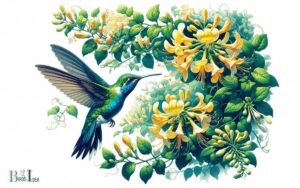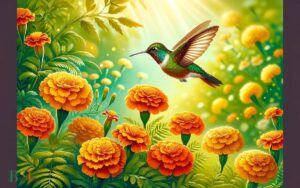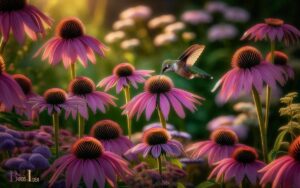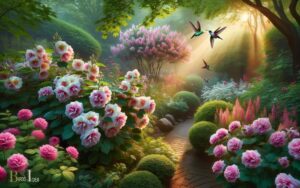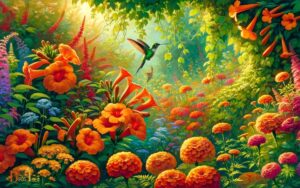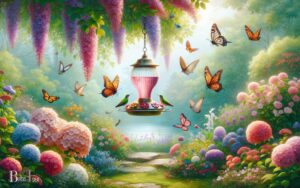Do Morning Glories Attract Hummingbirds? Yes!
Yes, morning glories are known to attract hummingbirds. These climbing vines produce trumpet-shaped flowers that are rich in nectar, which is a favorite food source for hummingbirds.
Morning glories are flowering plants that can be an excellent choice for gardeners looking to attract hummingbirds.
Their vibrant, trumpet-shaped flowers offer easy access to nectar, which is a high-energy food that hummingbirds seek out.
The blooms typically come in shades of blue, purple, pink, red, and white, and their bright colors are good at catching the attention of these fast-flying birds.
Additionally, morning glories have a long blooming period, which provides a consistent food source for hummingbirds throughout the growing season.
Here are a few reasons why morning glories are attractive to hummingbirds:
With their alluring trumpet-shaped blooms, morning glories provide an abundant source of nectar, making them a garden favorite for hummingbird enthusiasts.
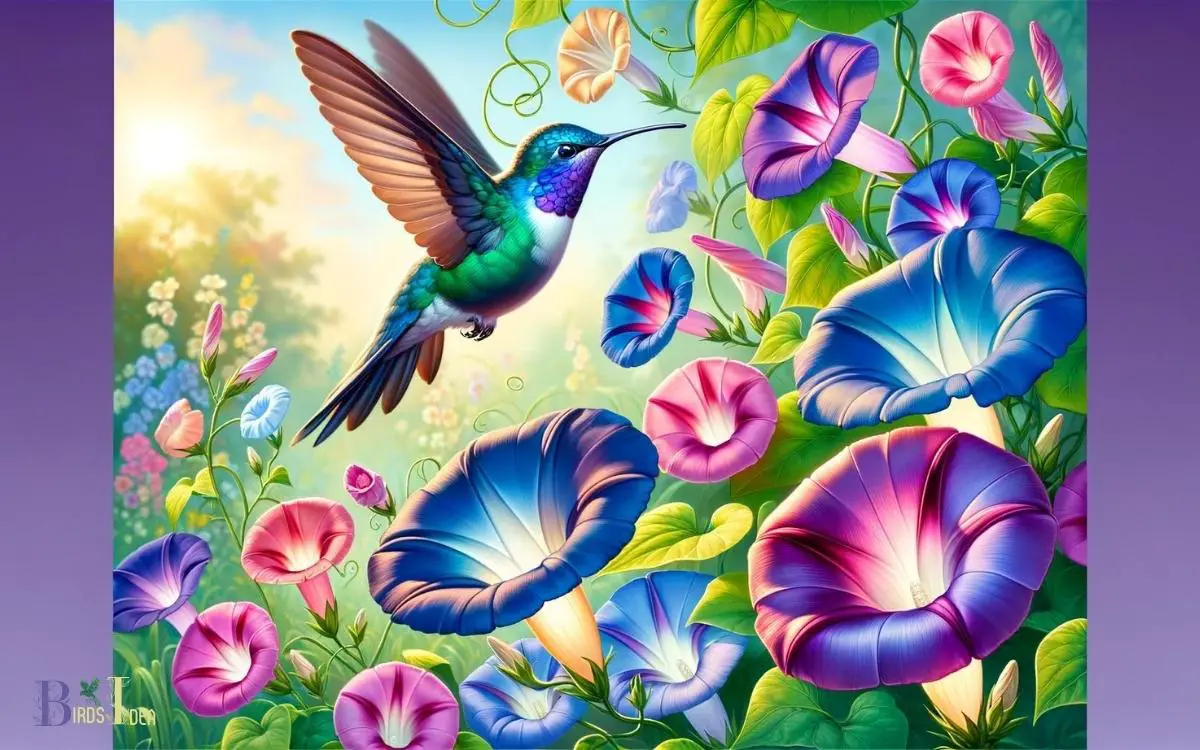
Key Takeaway
Characteristics of Morning Glories
Morning glories are known for their heart-shaped leaves and trumpet-shaped flowers, which come in a variety of colors.
These beautiful vines can grow up to 15 feet tall, and their flowers typically bloom in the morning and then begin to fade by afternoon.
The leaves of morning glories can vary in size and are typically a vibrant green color. The flowers can be found in shades of purple, blue, pink, and white, adding a delightful pop of color to any garden.
Morning glories are also known for their rapid growth, making them an excellent choice for covering fences, trellises, or arbors.
Their charming appearance and ease of cultivation make them a popular choice for many gardeners.
Hummingbird Attraction to Flowers
Yes, they are known to attract hummingbirds due to their trumpet-shaped flowers and abundant nectar production.
Hummingbirds are attracted to bright, tubular flowers that hold plenty of nectar, providing them with the energy they need for their high metabolism.
The following table illustrates some flowers that are particularly attractive to hummingbirds:
| Flower | Color |
|---|---|
| Trumpet Vine | Orange |
| Bee Balm | Red |
| Salvia | Red, Purple |
| Fuchsia | Pink, Red |
| Cardinal Flower | Red |
These flowers have evolved to meet the specific needs of hummingbirds, making them ideal for attracting these beautiful and energetic birds to your garden.
By planting these flowers, individuals can create an inviting environment that benefits both the birds and the beauty of their outdoor space.
Morning Glory Colors and Patterns
The colors and patterns of morning glories make them visually appealing to hummingbirds. These flowers come in a variety of colors, including shades of purple, pink, blue, and white, often with intricate patterns or gradients that create an eye-catching display.
The vibrant colors of morning glories attract hummingbirds, as these birds are known to be attracted to brightly colored flowers.
The patterns found on some morning glory blooms, such as striations or contrasting colors, can serve as visual cues for hummingbirds, guiding them to the flower’s nectar source.
Additionally, the tubular shape of the morning glory flower further enhances its appeal to hummingbirds, as it is well-suited for their long, slender bills.
Overall, the diverse colors and patterns of morning glories make them a charming and attractive option for hummingbirds seeking nectar.
Hummingbird Feeding Behavior
Many hummingbirds display voracious feeding behavior, visiting hundreds of flowers each day to meet their high energy demands.
Their feeding behavior is characterized by frequent visits to nectar-producing flowers, which provide the high sugar content necessary for their rapid metabolism.
Hummingbirds have the ability to hover in front of a flower while extracting nectar with their specialized, long, and tapered bills.
They use their extendable, grooved tongues to lap up the nectar at a rate of about 13 licks per second.
This efficient feeding method allows them to consume up to double their body weight in food daily.
Additionally, hummingbirds may also feed on small insects and spiders for protein, supplementing their diet with essential nutrients.
Understanding their feeding behavior is crucial for creating gardens that attract and support these remarkable birds.
Morning Glory Nectar Production
Morning glories produce nectar to attract pollinators such as hummingbirds, providing a valuable food source for these remarkable birds.
The nectar production of morning glories is an essential part of their reproductive strategy and plays a crucial role in supporting the ecosystem.
Here are some key points about morning glory nectar production:
- Nectar Composition: Morning glory nectar is rich in sucrose, glucose, and fructose, providing a high-energy source for hummingbirds.
- Nectar Quantity: Each morning glory flower can produce a varying amount of nectar, with some yielding more nectar than others.
- Nectar Refilling: Morning glory flowers have the ability to replenish their nectar throughout the day, ensuring a fresh supply for visiting hummingbirds.
- Nectar Accessibility: The structure of morning glory flowers makes it convenient for hummingbirds to access the nectar with their long, specialized bills.
- Nectar Timing: Morning glory flowers typically produce the most nectar during the early morning hours, coinciding with the peak feeding time for hummingbirds.
Hummingbird Garden Preferences
Hummingbirds are known to be drawn to a variety of flower colors in a garden, with bright reds, pinks, and oranges being particularly attractive to them. Additionally, they tend to favor nectar-rich plants like trumpet vines, bee balms, and salvias.
Understanding these preferences can help gardeners create an environment that is especially inviting to these delightful little birds.
Garden Flower Colors
The garden flower colors play a crucial role in attracting hummingbirds to a garden. Hummingbirds are attracted to a variety of flower colors, but some colors are more appealing to them than others.
Here are some garden flower colors that are particularly attractive to hummingbirds:
- Red: Hummingbirds are highly attracted to red flowers, as this color is easily visible to them from a distance.
- Orange: Bright orange flowers are also very appealing to hummingbirds and can help attract them to the garden.
- Pink: Light pink flowers, especially those with tubular shapes, can catch the attention of hummingbirds.
- Purple: Many hummingbird-pollinated flowers come in shades of purple, which are known to attract these birds.
- Bright Blue: Some species of hummingbirds are also attracted to bright blue flowers, adding variety to the garden color palette.
Nectar-Rich Plant Selection
When selecting nectar-rich plants for a hummingbird garden, it is essential to prioritize species known for their high nectar production and accessibility to hummingbirds.
Some popular choices include trumpet-shaped flowers like the bee balm, columbine, and red hot poker, which provide easy access for hummingbirds to sip nectar.
Additionally, tubular flowers such as the cardinal flower, salvia, and coral honeysuckle are also highly attractive to hummingbirds due to their rich nectar content.
It’s crucial to select a variety of nectar-rich plants that bloom at different times throughout the growing season, ensuring a consistent food source for these delightful birds.
By incorporating these preferences into the garden, enthusiasts can create an inviting environment that encourages hummingbirds to visit regularly.
Morning Glory Planting Tips
Morning Glory planting requires careful consideration of soil composition, sunlight exposure, and watering frequency for optimal growth.
When planting morning glories, keep the following tips in mind:
- Soil: Choose well-draining soil with a slightly acidic to neutral pH level.
- Sunlight: Morning glories thrive in full sunlight, so select a location with at least 6-8 hours of direct sunlight per day.
- Watering: These plants prefer moderate watering, so ensure the soil remains consistently moist but not waterlogged.
- Support: Provide a trellis or other support structure for the vines to climb and spread.
- Spacing: Plant seeds or seedlings about 6-12 inches apart to allow for proper growth and vine expansion.
Understanding these planting tips will help ensure the successful cultivation of morning glories in your garden, setting the stage for creating a hummingbird-friendly environment.
Creating a Hummingbird-Friendly Garden
A hummingbird-friendly garden requires strategically planting nectar-rich flowers to attract these tiny, vibrant birds.
When planning a garden to attract hummingbirds, consider incorporating a variety of flowers that bloom at different times throughout the year to provide a consistent nectar source.
Below is a table showcasing some nectar-rich flowers that are popular among hummingbirds:
| Flower | Blooming Season |
|---|---|
| Bee Balm | Summer |
| Salvia | Summer |
| Trumpet Vine | Summer to Fall |
| Coral Honeysuckle | Spring to Fall |
Conclusion
Morning glories can attract hummingbirds with their vibrant colors, nectar production, and trumpet-shaped flowers.
For example, a study conducted in a backyard garden found that planting a variety of morning glory colors and patterns, such as the blue ‘Heavenly Blue’ and the red ‘Scarlet O’Hara’, resulted in increased hummingbird visits and activity.
By incorporating morning glories into a hummingbird-friendly garden, enthusiasts can create a beautiful and inviting space for these beloved birds.

